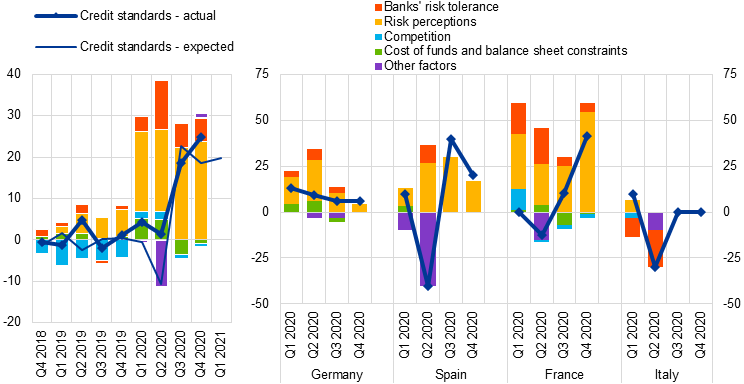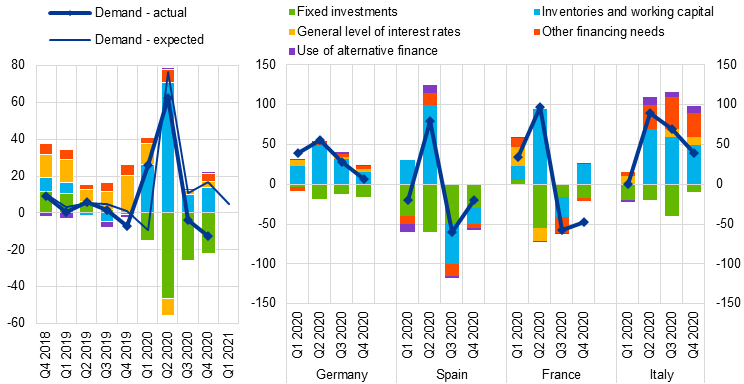- PRESS RELEASE
January 2021 euro area bank lending survey
19 January 2021
- Credit standards tightened for loans to enterprises and households
- Firms’ demand for loans continued to decline, while demand for housing loans increased
- Government guarantees on loans to firms supported bank lending conditions
Credit standards – i.e. banks’ internal guidelines or loan approval criteria – tightened across all loan categories, namely loans to enterprises, loans to households for house purchase and consumer credit and other lending to households in the fourth quarter of 2020, according to the January 2021 bank lending survey (BLS). The net percentage of banks reporting a tightening of credit standards for loans or credit lines to firms (net percentage of banks at 25%, see Chart 1) was somewhat higher than in the previous round. Credit standards for loans to households also tightened (a net percentage of 7% for loans to households for house purchase and 3% for consumer credit and other lending to households), but at a slower pace than in the previous quarters of 2020. Banks referred to the deterioration of the general economic outlook, increased credit risk of borrowers and a lower risk tolerance as relevant factors for the tightening of their credit standards for loans to firms and households. In the first quarter of 2021, banks expect credit standards to continue to tighten for loans to firms and households.
Banks’ overall terms and conditions – i.e. the actual terms and conditions agreed in loan contracts –tightened in the fourth quarter of 2020 for new loans to enterprises, with more stringent collateral requirements and wider loan margins, especially for riskier loans. For loans to households for house purchase, banks’ overall terms and conditions also tightened in the fourth quarter of 2020.
Firms’ demand for loans or drawing of credit lines declined further in net terms in the fourth quarter of 2020, with a larger percentage of banks indicating a decline than an increase in firms’ loan demand. Demand for inventories and working capital continued to contribute to an increase in demand, although its positive contribution was lower than in the first half of 2020. This might be explained by the precautionary liquidity buffers built up in previous quarters. Demand for loans for fixed investment declined for the fourth consecutive quarter (see Chart 2). Net demand for housing loans continued to increase in the fourth quarter of 2020, reflecting a catching-up in demand after the first lockdown period in the second quarter. For consumer credit and other lending to households a net percentage of banks reported a decline in demand, following a moderate increase in the previous quarter. Net demand for housing loans and consumer credit was supported by the low general level of interest rates, while lower consumer confidence continued to dampen demand. In the first quarter of 2021, banks expect net demand for loans to firms and for consumer credit to increase, while net demand for housing loans is expected to decline.
Euro area banks indicated that regulatory or supervisory action continued to strengthen banks’ capital position and had a strong easing impact on their funding conditions in 2020. Banks also reported that supervisory or regulatory action continued to have a net tightening impact on their credit standards across all loan categories.
Euro area banks reported that non-performing loans (NPLs) had a tightening impact on credit standards and on terms and conditions for loans to enterprises and consumer credit in the second half of 2020 (and a broadly neutral impact for housing loans). Risk perceptions and risk aversion were the main drivers of the tightening impact of NPL ratios.
Looking at a sectoral breakdown, respondent banks indicated a net tightening of credit standards for loans to enterprises across all main sectors of economic activities in the second half of 2020. The net tightening was most pronounced for loans to firms in the commercial real estate and the wholesale and retail trade sectors.
Banks reported that coronavirus (COVID-19)-related government guarantees supported credit standards and helped keep terms and conditions for loans to firms more favourable in 2020. Banks also indicated a very strong net increase in demand for loans or credit lines with government guarantees in the first half of 2020, while the net increase in the second half was moderate, reflecting reduced liquidity needs.
The euro area bank lending survey, which is conducted four times a year, was developed by the Eurosystem in order to improve its understanding of banks’ lending behaviour in the euro area. The results reported in the January 2021 survey relate to changes observed in the fourth quarter of 2020 and expected changes in the first quarter of 2021, unless otherwise indicated. The January 2021 survey round was conducted between 4 and 29 December 2020. A total of 143 banks were surveyed in this round, with a response rate of 100%.
For media queries, please contact Silvia Margiocco tel.: +49 69 1344 6619.
Notes
- A report on this survey round is available at https://www.ecb.europa.eu/stats/ecb_surveys/bank_lending_survey/html/index.en.html. A copy of the questionnaire, a glossary of BLS terms and a BLS user guide with information on the BLS series keys can also be found on that web page.
- The euro area and national data series are available on the ECB’s website via the Statistical Data Warehouse (http://sdw.ecb.europa.eu/browse.do?node=9691151). National results, as published by the respective national central banks, can be obtained via https://www.ecb.europa.eu/stats/ecb_surveys/bank_lending_survey/html/index.en.html.
- For more detailed information on the bank lending survey, see Köhler-Ulbrich, P., Hempell, H. and Scopel, S., “The euro area bank lending survey”, Occasional Paper Series, No 179, ECB, 2016 (http://www.ecb.europa.eu/pub/pdf/scpops/ecbop179.en.pdf).
Chart 1
Changes in credit standards for loans or credit lines to enterprises and contributing factors
(net percentages of banks reporting a tightening of credit standards and contributing factors)

Source: ECB (BLS).
Notes: Net percentages are defined as the difference between the sum of the percentages of banks responding “tightened considerably” and “tightened somewhat” and the sum of the percentages of banks responding “eased somewhat” and “eased considerably”.
Chart 2
Changes in demand for loans or credit lines to enterprises and contributing factors
(net percentages of banks reporting an increase in demand and contributing factors)

Source: ECB (BLS).
Notes: Net percentages for the questions on demand for loans are defined as the difference between the sum of the percentages of banks responding “increased considerably” and “increased somewhat” and the sum of the percentages of banks responding “decreased somewhat” and “decreased considerably”.
European Central Bank
Directorate General Communications
- Sonnemannstrasse 20
- 60314 Frankfurt am Main, Germany
- +49 69 1344 7455
- media@ecb.europa.eu
Reproduction is permitted provided that the source is acknowledged.
Media contacts

